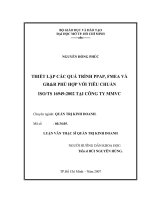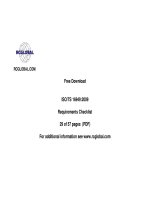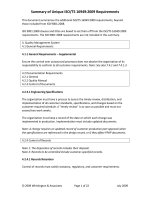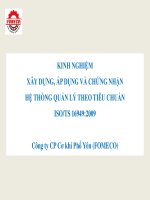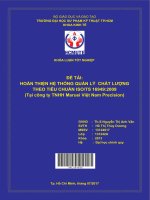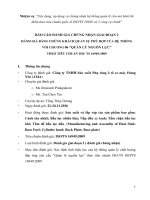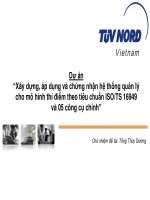Tiêu chuẩn iso ts 16949 2009
Bạn đang xem bản rút gọn của tài liệu. Xem và tải ngay bản đầy đủ của tài liệu tại đây (425.01 KB, 52 trang )
ISO/TS
16949
TECHNICAL
SPECIFICATION
Third edition
2009-06-15
Quality management systems —
Systèmes de management de la qualité —
Exigences particulières pour l'application de l'ISO 9001:2008 pour la
production de série et de pièces de rechange dans l'industrie automobile
--`,,```,,,,````-`-`,,`,,`,`,,`---
Particular requirements for the application
of ISO 9001:2008 for automotive production
and relevant service part organizations
Reference number
ISO/TS 16949:2009(E)
© ISO 2009
Copyright International Organization for Standardization
Provided by IHS under license with ISO
No reproduction or networking permitted without license from IHS
Not for Resale
ISO/TS 16949:2009(E)
PDF disclaimer
This PDF file may contain embedded typefaces. In accordance with Adobe's licensing policy, this file may be printed or viewed but
shall not be edited unless the typefaces which are embedded are licensed to and installed on the computer performing the editing. In
downloading this file, parties accept therein the responsibility of not infringing Adobe's licensing policy. The ISO Central Secretariat
accepts no liability in this area.
Adobe is a trademark of Adobe Systems Incorporated.
Copyright notice
This ISO document is copyright-protected by ISO. Except as permitted under the applicable laws of the user's country, neither this ISO
draft nor any extract from it may be reproduced, stored in a retrieval system or transmitted in any form or by any means, electronic,
photocopying, recording or otherwise, without prior written permission being secured.
Requests for permission to reproduce should be addressed to either ISO at the address below or ISO's member body in the country of
the requester.
ISO copyright office
Case postale 56 • CH-1211 Geneva 20
Tel. + 41 22 749 01 11
Fax + 41 22 749 09 47
Web www.iso.org
Reproduction may be subject to royalty payments or a licensing agreement.
Violators may be prosecuted.
The content inside the boxed text of this document is ISO 9001:2008 text and is protected by the above
copyright statement.
The text outside the boxes has been originated by the International Automotive Task Force. Copyright for this
text is held by ANFIA, FIEV, SMMT, VDA (see below) and the car manufacturers Chrysler, Ford Motor
Company, General Motors Corp, PSA Peugeot Citroën, Renault.
Neither this Technical Specification nor any extract from it may be reproduced in a retrieval system or
transmitted in any form or by any means, electronic, photocopying, recording or otherwise without prior written
permission being secured.
Requests for permission to reproduce and/or translate non-boxed text should be addressed to one of the
addresses below:
International Automotive Oversight Bureau (IAOB/USA)
Associazione Nazionale Filiera Industrie Automobilistiche (ANFIA/Italy)
Fédération des Industries des Équipements pour Véhicules (FIEV/France)
Society of Motor Manufacturers and Traders (SMMT/UK)
Verband der Automobilindustrie - Qualitätsmanagement Center (VDA-QMC/Germany)
© ISO 2009 – All rights reserved
© ANFIA, © FIEV, © SMMT, © VDA, © Chrysler, © Ford Motor Company, © General Motors Corp. – All rights reserved
ii
© PSA Peugeot Citroën, © Renault – All rights reserved
Copyright International Organization for Standardization
Provided by IHS under license with ISO
No reproduction or networking permitted without license from IHS
Not for Resale
--`,,```,,,,````-`-`,,`,,`,`,,`---
Details of the software products used to create this PDF file can be found in the General Info relative to the file; the PDF-creation
parameters were optimized for printing. Every care has been taken to ensure that the file is suitable for use by ISO member bodies. In
the unlikely event that a problem relating to it is found, please inform the Central Secretariat at the address given below.
ISO/TS 16949:2009(E)
Contents
Page
Foreword..............................................................................................................................................................vii
Remarks for certification .....................................................................................................................................viii
Introduction .......................................................................................................................................................... ix
0.1 General.................................................................................................................................................... ix
0.2 Process approach..................................................................................................................................... x
0.3 Relationship with ISO 9004 .................................................................................................................... xii
0.4 Compatibility with other management systems ...................................................................................... xii
0.5 Goal of this Technical Specification....................................................................................................... xii
1 Scope................................................................................................................................................................1
1.1 General.....................................................................................................................................................1
1.2 Application ................................................................................................................................................1
2 Normative references .......................................................................................................................................2
3 Terms and definitions .......................................................................................................................................2
3.1 Terms and definitions for the automotive industry....................................................................................2
4 Quality management system ............................................................................................................................4
4.1 General requirements...............................................................................................................................4
4.1.1 General requirements — Supplemental ...........................................................................................4
4.2 Documentation requirements ...................................................................................................................5
4.2.1 General.............................................................................................................................................5
4.2.2 Quality manual..................................................................................................................................5
--`,,```,,,,````-`-`,,`,,`,`,,`---
4.2.3 Control of documents .......................................................................................................................6
4.2.3.1 Engineering specifications.............................................................................................................6
4.2.4 Control of records.............................................................................................................................6
4.2.4.1 Records retention ..........................................................................................................................7
5 Management responsibility ...............................................................................................................................7
5.1 Management commitment........................................................................................................................7
5.1.1 Process efficiency ............................................................................................................................7
5.2 Customer focus ........................................................................................................................................7
5.3 Quality policy.............................................................................................................................................7
5.4 Planning....................................................................................................................................................8
5.4.1 Quality objectives .............................................................................................................................8
5.4.1.1 Quality objectives — Supplemental...............................................................................................8
5.4.2 Quality management system planning .............................................................................................8
5.5 Responsibility, authority and communication............................................................................................8
5.5.1 Responsibility and authority..............................................................................................................8
5.5.1.1 Responsibility for quality................................................................................................................8
5.5.2 Management representative.............................................................................................................9
5.5.2.1 Customer representative ...............................................................................................................9
5.5.3 Internal communication ....................................................................................................................9
5.6 Management review .................................................................................................................................9
5.6.1 General.............................................................................................................................................9
5.6.1.1 Quality management system performance..................................................................................10
5.6.2 Review input ...................................................................................................................................10
5.6.2.1 Review input — Supplemental ....................................................................................................10
5.6.3 Review output.................................................................................................................................10
© ISO 2009 – All rights reserved
© ANFIA, © FIEV, © SMMT, © VDA, © Chrysler, © Ford Motor Company, © General Motors Corp. – All rights reserved
© PSA Peugeot Citroën, © Renault – All rights reserved
Copyright International Organization for Standardization
Provided by IHS under license with ISO
No reproduction or networking permitted without license from IHS
Not for Resale
iii
ISO/TS 16949:2009(E)
6 Resource management...................................................................................................................................11
6.1 Provision of resources ............................................................................................................................11
6.2 Human resources ...................................................................................................................................11
6.2.1 General ...........................................................................................................................................11
6.2.2 Competence, training and awareness ............................................................................................11
6.2.2.1 Product design skills ....................................................................................................................11
6.2.2.2 Training ........................................................................................................................................12
6.2.2.3 Training on the job .......................................................................................................................12
6.2.2.4 Employee motivation and empowerment.....................................................................................12
6.3 Infrastructure...........................................................................................................................................12
6.3.1 Plant, facility and equipment planning ............................................................................................12
6.3.2 Contingency plans ..........................................................................................................................12
6.4 Work environment ..................................................................................................................................13
6.4.1 Personnel safety to achieve conformity to product requirements ...................................................13
6.4.2 Cleanliness of premises..................................................................................................................13
7 Product realization ..........................................................................................................................................13
7.1 Planning of product realization................................................................................................................13
7.1.1 Planning of product realization — Supplemental ............................................................................14
7.1.2 Acceptance criteria .........................................................................................................................14
7.1.3 Confidentiality .................................................................................................................................14
7.1.4 Change control ...............................................................................................................................14
7.2 Customer-related processes...................................................................................................................14
7.2.1 Determination of requirements related to the product ....................................................................14
7.2.1.1 Customer-designated special characteristics ..............................................................................15
7.2.2 Review of requirements related to the product ...............................................................................15
7.2.2.1 Review of requirements related to the product — Supplemental ................................................15
7.2.2.2 Organization manufacturing feasibility .........................................................................................15
7.2.3 Customer communication...............................................................................................................15
7.2.3.1 Customer communication — Supplemental ................................................................................16
7.3 Design and development ........................................................................................................................16
7.3.1 Design and development planning .................................................................................................16
7.3.1.1 Multidisciplinary approach............................................................................................................16
7.3.2 Design and development inputs .....................................................................................................17
7.3.2.1 Product design input ....................................................................................................................17
7.3.2.2 Manufacturing process design input ............................................................................................17
7.3.2.3 Special characteristics .................................................................................................................17
7.3.3 Design and development outputs ...................................................................................................18
7.3.3.1 Product design outputs — Supplemental ....................................................................................18
7.3.3.2 Manufacturing process design output..........................................................................................18
7.3.4 Design and development review.....................................................................................................19
7.3.4.1 Monitoring ....................................................................................................................................19
7.3.5 Design and development verification..............................................................................................19
7.3.6 Design and development validation ................................................................................................19
7.3.6.1 Design and development validation — Supplemental .................................................................19
7.3.6.2 Prototype programme ..................................................................................................................20
7.3.6.3 Product approval process ............................................................................................................20
7.3.7 Control of design and development changes .................................................................................20
© ISO 2009 – All rights reserved
© ANFIA, © FIEV, © SMMT, © VDA, © Chrysler, © Ford Motor Company, © General Motors Corp. – All rights reserved
iv
© PSA Peugeot Citroën, © Renault – All rights reserved
Copyright International Organization for Standardization
--`,,```,,,,````-`-`,,`,,`,`,,`---
Provided by IHS under license with ISO
No reproduction or networking permitted without license from IHS
Not for Resale
ISO/TS 16949:2009(E)
7.4 Purchasing..............................................................................................................................................20
7.4.1 Purchasing process........................................................................................................................20
7.4.1.1 Statutory and regulatory conformity ............................................................................................21
7.4.1.2 Supplier quality management system development ....................................................................21
7.4.1.3 Customer-approved sources .......................................................................................................21
7.4.2 Purchasing information...................................................................................................................21
--`,,```,,,,````-`-`,,`,,`,`,,`---
7.4.3 Verification of purchased product...................................................................................................21
7.4.3.1 Incoming product conformity to requirements .............................................................................22
7.4.3.2 Supplier monitoring......................................................................................................................22
7.5 Production and service provision............................................................................................................22
7.5.1 Control of production and service provision ...................................................................................22
7.5.1.1 Control plan ..................................................................................................................................22
7.5.1.2 Work instructions.........................................................................................................................23
7.5.1.3 Verification of job set-ups ............................................................................................................23
7.5.1.4 Preventive and predictive maintenance ......................................................................................23
7.5.1.5 Management of production tooling ..............................................................................................24
7.5.1.6 Production scheduling .................................................................................................................24
7.5.1.7 Feedback of information from service .........................................................................................24
7.5.1.8 Service agreement with customer ...............................................................................................24
7.5.2 Validation of processes for production and service provision ........................................................24
7.5.2.1 Validation of processes for production and service provision — Supplemental..........................25
7.5.3 Identification and traceability ..........................................................................................................25
7.5.3.1 Identification and traceability — Supplemental............................................................................25
7.5.4 Customer property..........................................................................................................................25
7.5.4.1 Customer-owned production tooling............................................................................................25
7.5.5 Preservation of product ..................................................................................................................26
7.5.5.1 Storage and inventory .................................................................................................................26
7.6 Control of monitoring and measuring equipment ...................................................................................26
7.6.1 Measurement system analysis .......................................................................................................27
7.6.2 Calibration/verification records .......................................................................................................27
7.6.3 Laboratory requirements ................................................................................................................27
7.6.3.1 Internal laboratory........................................................................................................................27
7.6.3.2 External laboratory ......................................................................................................................27
8 Measurement, analysis and improvement......................................................................................................28
8.1 General...................................................................................................................................................28
8.1.1 Identification of statistical tools .......................................................................................................28
8.1.2 Knowledge of basic statistical concepts .........................................................................................28
8.2 Monitoring and measurement.................................................................................................................28
8.2.1 Customer satisfaction.....................................................................................................................28
8.2.1.1 Customer satisfaction — Supplemental ......................................................................................29
8.2.2 Internal audit...................................................................................................................................29
8.2.2.1 Quality management system audit ..............................................................................................29
8.2.2.2 Manufacturing process audit .......................................................................................................29
8.2.2.3 Product audit ...............................................................................................................................30
8.2.2.4 Internal audit plans ......................................................................................................................30
8.2.2.5 Internal auditor qualification.........................................................................................................30
8.2.3 Monitoring and measurement of processes ...................................................................................30
8.2.3.1 Monitoring and measurement of manufacturing processes ........................................................30
© ISO 2009 – All rights reserved
© ANFIA, © FIEV, © SMMT, © VDA, © Chrysler, © Ford Motor Company, © General Motors Corp. – All rights reserved
© PSA Peugeot Citroën, © Renault – All rights reserved
Copyright International Organization for Standardization
Provided by IHS under license with ISO
No reproduction or networking permitted without license from IHS
Not for Resale
v
ISO/TS 16949:2009(E)
8.2.4 Monitoring and measurement of product........................................................................................31
8.2.4.1 Layout inspection and functional testing......................................................................................31
8.2.4.2 Appearance items ........................................................................................................................31
8.3 Control of nonconforming product ..........................................................................................................32
8.3.1 Control of nonconforming product — Supplemental.......................................................................32
8.3.2 Control of reworked product ...........................................................................................................32
8.3.3 Customer information .....................................................................................................................32
8.3.4 Customer waiver.............................................................................................................................32
8.4 Analysis of data.......................................................................................................................................33
8.4.1 Analysis and use of data.................................................................................................................33
8.5 Improvement...........................................................................................................................................33
8.5.1 Continual improvement...................................................................................................................33
8.5.1.1 Continual improvement of the organization .................................................................................33
8.5.1.2 Manufacturing process improvement...........................................................................................34
8.5.2 Corrective action.............................................................................................................................34
8.5.2.1 Problem solving ...........................................................................................................................34
8.5.2.2 Error-proofing...............................................................................................................................34
8.5.2.3 Corrective action impact ..............................................................................................................34
8.5.2.4 Rejected product test/analysis.....................................................................................................34
8.5.3 Preventive action ............................................................................................................................35
Annex A (normative) Control plan ......................................................................................................................36
A.2 Elements of the control plan ...................................................................................................................36
Bibliography.........................................................................................................................................................38
NOTE
In this table of contents, ISO 9001:2008 headings are normal type face, IATF headings are in italics.
© ISO 2009 – All rights reserved
© ANFIA, © FIEV, © SMMT, © VDA, © Chrysler, © Ford Motor Company, © General Motors Corp. – All rights reserved
vi
© PSA Peugeot Citroën, © Renault – All rights reserved
Copyright International Organization for Standardization
Provided by IHS under license with ISO
No reproduction or networking permitted without license from IHS
Not for Resale
--`,,```,,,,````-`-`,,`,,`,`,,`---
A.1 Phases of the control plan ......................................................................................................................36
ISO/TS 16949:2009(E)
Foreword
ISO (the International Organization for Standardization) is a worldwide federation of national standards bodies
(ISO member bodies). The work of preparing International Standards is normally carried out through ISO
technical committees. Each member body interested in a subject for which a technical committee has been
established has the right to be represented on that committee. International organizations, governmental and
non-governmental, in liaison with ISO, also take part in the work. ISO collaborates closely with the International
Electrotechnical Commission (IEC) on all matters of electrotechnical standardization.
International Standards are drafted in accordance with the rules given in the ISO/IEC Directives, Part 2.
The main task of technical committees is to prepare International Standards. Draft International Standards
adopted by the technical committees are circulated to the member bodies for voting. Publication as an
International Standard requires approval by at least 75 % of the member bodies casting a vote.
In other circumstances, particularly when there is an urgent market requirement for such documents, a
technical committee may decide to publish other types of normative document:
⎯ an ISO Publicly Available Specification (ISO/PAS) represents an agreement between technical experts
in an ISO working group and is accepted for publication if it is approved by more than 50 % of the
members of the parent committee casting a vote;
⎯ an ISO Technical Specification (ISO/TS) represents an agreement between the members of a
technical committee and is accepted for publication if it is approved by 2/3 of the members of the
committee casting a vote.
ISO/TS 16949 was prepared by the International Automotive Task Force (IATF), with support from ISO/TC 176,
Quality management and quality assurance.
This third edition of ISO/TS 16949 cancels and replaces the second edition (ISO/TS 16949:2002), which has
been technically amended according to ISO 9001:2008.
Boxed text is original ISO 9001:2008 text. The sector-specific supplemental requirements are outside the
boxes.
In this Technical Specification, the word “shall” indicates a requirement. The word “should” indicates a
recommendation. Paragraphs marked “NOTE” are for guidance in understanding or clarifying the associated
requirement.
Where the term “such as” is used, any suggestions given are for guidance only.
Annex A forms a normative part of this Technical Specification.
--`,,```,,,,````-`-`,,`,,`,`,,`---
© ISO 2009 – All rights reserved
© ANFIA, © FIEV, © SMMT, © VDA, © Chrysler, © Ford Motor Company, © General Motors Corp. – All rights reserved
© PSA Peugeot Citroën, © Renault – All rights reserved
Copyright International Organization for Standardization
Provided by IHS under license with ISO
No reproduction or networking permitted without license from IHS
Not for Resale
vii
ISO/TS 16949:2009(E)
Remarks for certification
The certification to this Technical Specification, including customer-specific requirements if any, is recognized
by the customer members of IATF when achieved according to the IATF certification scheme (see the “Rules
for achieving IATF recognition”).
Details can be obtained at the addresses of the local oversight offices of IATF cited below:
Associazione Nazionale Filiera Industrie Automobilistiche (ANFIA)
Web site: www.anfia.it
e-mail:
International Automotive Oversight Bureau (IAOB)
Web site: www.iaob.org
e-mail:
IATF-France
Web site: www.iatf-france.com
e-mail:
Society of Motor Manufacturers and Traders Ltd. (SMMT Ltd.)
Web site: www.smmt.co.uk
e-mail:
Verband der Automobilindustrie Qualitätsmanagement Center (VDA-QMC)
Web site: www.vda-qmc.de
e-mail:
--`,,```,,,,````-`-`,,`,,`,`,,`---
All public information about IATF can be found at: www.iatfglobaloversight.org
© ISO 2009 – All rights reserved
© ANFIA, © FIEV, © SMMT, © VDA, © Chrysler, © Ford Motor Company, © General Motors Corp. – All rights reserved
viii
© PSA Peugeot Citroën, © Renault – All rights reserved
Copyright International Organization for Standardization
Provided by IHS under license with ISO
No reproduction or networking permitted without license from IHS
Not for Resale
ISO/TS 16949:2009(E)
Introduction
0.1 General
ISO 9001:2008, Quality management systems — Requirements
0.1 General
The adoption of a quality management system should be a strategic decision of an organization. The design
and implementation of an organization's quality management system is influenced by
a) its organizational environment, changes in that environment, and the risks associated with that
environment,
b) its varying needs,
c) its particular objectives,
d)
the products it provides,
e)
the processes it employs,
f)
its size and organizational structure.
It is not the intent of this International Standard to imply uniformity in the structure of quality management
systems or uniformity of documentation.
The quality management system requirements specified in this International Standard are complementary to
requirements for products. Information marked “NOTE” is for guidance in understanding or clarifying the
associated requirement.
This International Standard can be used by internal and external parties, including certification bodies, to
assess the organization's ability to meet customer, statutory and regulatory requirements applicable to the
product, and the organization's own requirements.
The quality management principles stated in ISO 9000 and ISO 9004 have been taken into consideration
during the development of this International Standard.
© ISO 2009 – All rights reserved
© ANFIA, © FIEV, © SMMT, © VDA, © Chrysler, © Ford Motor Company, © General Motors Corp. – All rights reserved
© PSA Peugeot Citroën, © Renault – All rights reserved
Copyright International Organization for Standardization
Provided by IHS under license with ISO
No reproduction or networking permitted without license from IHS
Not for Resale
ix
--`,,```,,,,````-`-`,,`,,`,`,,`---
Introduction
ISO/TS 16949:2009(E)
0.2 Process approach
ISO 9001:2008, Quality management systems — Requirements
0.2 Process approach
This International Standard promotes the adoption of a process approach when developing, implementing
and improving the effectiveness of a quality management system, to enhance customer satisfaction by
meeting customer requirements.
For an organization to function effectively, it has to determine and manage numerous linked activities. An
activity or set of activities using resources, and managed in order to enable the transformation of inputs into
outputs, can be considered as a process. Often the output from one process directly forms the input to the
next.
The application of a system of processes within an organization, together with the identification and
interactions of these processes, and their management to produce the desired outcome, can be referred to
as the “process approach”.
An advantage of the process approach is the ongoing control that it provides over the linkage between the
individual processes within the system of processes, as well as over their combination and interaction.
When used within a quality management system, such an approach emphasizes the importance of
a)
understanding and meeting requirements,
b)
the need to consider processes in terms of added value,
c)
obtaining results of process performance and effectiveness, and
d)
continual improvement of processes based on objective measurement.
© ISO 2009 – All rights reserved
© ANFIA, © FIEV, © SMMT, © VDA, © Chrysler, © Ford Motor Company, © General Motors Corp. – All rights reserved
x
© PSA Peugeot Citroën, © Renault – All rights reserved
Copyright International Organization for Standardization
--`,,```,,,,````-`-`,,`,,`,`,,`---
Provided by IHS under license with ISO
No reproduction or networking permitted without license from IHS
Not for Resale
ISO/TS 16949:2009(E)
The model of a process-based quality management system shown in Figure 1 illustrates the process
linkages presented in Clauses 4 to 8. This illustration shows that customers play a significant role in
defining requirements as inputs. Monitoring of customer satisfaction requires the evaluation of information
relating to customer perception as to whether the organization has met the customer requirements. The
model shown in Figure 1 covers all the requirements of this International Standard, but does not show
processes at a detailed level.
NOTE In addition, the methodology known as “Plan-Do-Check-Act” (PDCA) can be applied to all processes. PDCA
can be briefly described as follows.
Plan: establish the objectives and processes necessary to deliver results in accordance with customer
requirements and the organization's policies.
Do: implement the processes.
Check: monitor and measure processes and product against policies, objectives and requirements for the product
and report the results.
Act: take actions to continually improve process performance.
--`,,```,,,,````-`-`,,`,,`,`,,`---
Figure 1 — Model of a process-based quality management system
© ISO 2009 – All rights reserved
© ANFIA, © FIEV, © SMMT, © VDA, © Chrysler, © Ford Motor Company, © General Motors Corp. – All rights reserved
© PSA Peugeot Citroën, © Renault – All rights reserved
Copyright International Organization for Standardization
Provided by IHS under license with ISO
No reproduction or networking permitted without license from IHS
Not for Resale
xi
ISO/TS 16949:2009(E)
0.3 Relationship with ISO 9004
ISO 9001:2008, Quality management systems — Requirements
0.3 Relationship with ISO 9004
ISO 9001 and ISO 9004 are quality management system standards which have been designed to
complement each other, but can also be used independently.
ISO 9001 specifies requirements for a quality management system that can be used for internal application
by organizations, or for certification, or for contractual purposes. It focuses on the effectiveness of the
quality management system in meeting customer requirements.
At the time of publication of this International Standard, ISO 9004 is under revision. The revised edition of
ISO 9004 will provide guidance to management for achieving sustained success for any organization in a
complex, demanding, and ever changing, environment. ISO 9004 provides a wider focus on quality
management than ISO 9001; it addresses the needs and expectations of all interested parties and their
satisfaction, by the systematic and continual improvement of the organization’s performance. However, it is
not intended for certification, regulatory or contractual use.
NOTE
The knowledge and use of the eight quality management principles referred to in ISO 9000:2005 and
ISO 9004:— should be demonstrated and cascaded through the organization by top management.
0.4 Compatibility with other management systems
ISO 9001:2008, Quality management systems — Requirements
0.4 Compatibility with other management systems
During the development of this International Standard, due consideration was given to the provisions of ISO
14001:2004 to enhance the compatibility of the two standards for the benefit of the user community. Annex
A shows the correspondence between ISO 9001:2008 and ISO 14001:2004.
This International Standard does not include requirements specific to other management systems, such as
those particular to environmental management, occupational health and safety management, financial
management or risk management. However, this International Standard enables an organization to align or
integrate its own quality management system with related management system requirements. It is possible
for an organization to adapt its existing management system(s) in order to establish a quality management
system that complies with the requirements of this International Standard.
0.5 Goal of this Technical Specification
The goal of this Technical Specification is the development of a quality management system that provides for
continual improvement, emphasizing defect prevention and the reduction of variation and waste in the supply
chain.
This Technical Specification, coupled with applicable customer-specific requirements, defines the fundamental
quality management system requirements for those subscribing to this Technical Specification.
This Technical Specification is intended to avoid multiple certification audits and provide a common approach
to a quality management system for automotive production, and relevant service part organizations.
© ISO 2009 – All rights reserved
© ANFIA, © FIEV, © SMMT, © VDA, © Chrysler, © Ford Motor Company, © General Motors Corp. – All rights reserved
xii
© PSA Peugeot Citroën, © Renault – All rights reserved
Copyright International Organization for Standardization
--`,,```,,,,````-`-`,,`,,`,`,,`---
Provided by IHS under license with ISO
No reproduction or networking permitted without license from IHS
Not for Resale
TECHNICAL SPECIFICATION
ISO/TS 16949:2009(E)
Quality management systems — Particular requirements for the
application of ISO 9001:2008 for automotive production and
relevant service part organizations
1 Scope
1.1 General
ISO 9001:2008, Quality management systems — Requirements
1 Scope
1.1 General
This International Standard specifies requirements for a quality management system where an organization
a) needs to demonstrate its ability to consistently provide product that meets customer and applicable
statutory and regulatory requirements, and
b) aims to enhance customer satisfaction through the effective application of the system, including
processes for continual improvement of the system and the assurance of conformity to customer and
applicable statutory and regulatory requirements.
NOTE 1 In this International Standard, the term “product” only applies to
a)
product intended for, or required by, a customer,
b)
any intended output resulting from the product realization processes.
NOTE 2 Statutory and regulatory requirements can be expressed as legal requirements.
This Technical Specification, in conjunction with ISO 9001:2008, defines the quality management system
requirements for the design and development, production and, when relevant, installation and service of
automotive-related products.
This Technical Specification is applicable to sites of the organization where customer-specified parts, for
production and/or service, are manufactured.
Supporting functions, whether on-site or remote (such as design centres, corporate headquarters and
distribution centres), form part of the site audit as they support the site, but cannot obtain stand-alone
certification to this Technical Specification.
This Technical Specification can be applied throughout the automotive supply chain.
1.2 Application
ISO 9001:2008, Quality management systems — Requirements
1.2 Application
All requirements of this International Standard are generic and are intended to be applicable to all
organizations, regardless of type, size and product provided.
© ISO 2009 – All rights reserved
© ANFIA, © FIEV, © SMMT, © VDA, © Chrysler, © Ford Motor Company, © General Motors Corp. – All rights reserved
© PSA Peugeot Citroën, © Renault – All rights reserved
Copyright International Organization for Standardization
--`,,```,,,,````-`-`,,`,,`,`,,`---
Provided by IHS under license with ISO
No reproduction or networking permitted without license from IHS
Not for Resale
1
ISO/TS 16949:2009(E)
Where any requirement(s) of this International Standard cannot be applied due to the nature of an
organization and its product, this can be considered for exclusion.
Where exclusions are made, claims of conformity to this International Standard are not acceptable unless
these exclusions are limited to requirements within Clause 7, and such exclusions do not affect the
organization's ability, or responsibility, to provide product that meets customer and applicable statutory and
regulatory requirements.
The only permitted exclusions for this Technical Specification relate to 7.3 where the organization is
not responsible for product design and development.
Permitted exclusions do not include manufacturing process design.
2 Normative references
The following referenced documents are indispensable for the application of this document. For dated
references, only the edition cited applies. For undated references, the latest edition of the referenced
document (including any amendments) applies.
ISO 9000:2005, Quality management systems — Fundamentals and vocabulary
3 Terms and definitions
ISO 9001:2008, Quality management systems — Requirements
3
Terms and definitions
For the purposes of this document, the terms and definitions given in ISO 9000 apply.
Throughout the text of this International Standard, wherever the term “product” occurs, it can also mean
“service”.
3.1 Terms and definitions for the automotive industry
For the purposes of this document, the terms and definitions given in ISO 9000:2005 and the following apply.
3.1.1
control plan
documented description of the systems and processes required for controlling product
NOTE
See Annex A.
3.1.2
design responsible organization
organization with authority to establish a new, or change an existing, product specification
NOTE
This responsibility includes testing and verification of design performance within the customer's specified
application.
3.1.3
error proofing
product and manufacturing process design and development to prevent manufacture of nonconforming
products
3.1.4
laboratory
facility for inspection, test or calibration that may include, but is not limited to, chemical, metallurgical,
dimensional, physical, electrical or reliability testing
© ISO 2009 – All rights reserved
© ANFIA, © FIEV, © SMMT, © VDA, © Chrysler, © Ford Motor Company, © General Motors Corp. – All rights reserved
2
© PSA Peugeot Citroën, © Renault – All rights reserved
Copyright International Organization for Standardization
--`,,```,,,,````-`-`,,`,,`,`,,`---
Provided by IHS under license with ISO
No reproduction or networking permitted without license from IHS
Not for Resale
ISO/TS 16949:2009(E)
3.1.5
laboratory scope
controlled document containing
⎯
specific tests, evaluations and calibrations that a laboratory is qualified to perform,
⎯
a list of the equipment which it uses to perform the above, and
⎯
a list of methods and standards to which it performs the above
3.1.6
manufacturing
process of making or fabricating
⎯
production materials,
⎯
production or service parts,
⎯
assemblies, or
⎯
heat treating, welding, painting, plating or other finishing services
3.1.7
predictive maintenance
activities based on process data aimed at the avoidance of maintenance problems by prediction of likely failure
modes
3.1.8
preventive maintenance
planned action to eliminate causes of equipment failure and unscheduled interruptions to production, as an
output of the manufacturing process design
3.1.9
premium freight
extra costs or charges incurred additional to contracted delivery
NOTE
This can be caused by method, quantity, unscheduled or late deliveries, etc.
3.1.10
remote location
location that supports sites and at which non-production processes occur
3.1.11
site
location at which value-added manufacturing processes occur
3.1.12
special characteristic
product characteristic or manufacturing process parameter which can affect safety or compliance with
regulations, fit, function, performance or subsequent processing of product
--`,,```,,,,````-`-`,,`,,`,`,,`---
© ISO 2009 – All rights reserved
© ANFIA, © FIEV, © SMMT, © VDA, © Chrysler, © Ford Motor Company, © General Motors Corp. – All rights reserved
© PSA Peugeot Citroën, © Renault – All rights reserved
Copyright International Organization for Standardization
Provided by IHS under license with ISO
No reproduction or networking permitted without license from IHS
Not for Resale
3
ISO/TS 16949:2009(E)
4 Quality management system
4.1 General requirements
ISO 9001:2008, Quality management systems — Requirements
4
Quality management system
4.1 General requirements
The organization shall establish, document, implement and maintain a quality management system and
continually improve its effectiveness in accordance with the requirements of this International Standard.
The organization shall
a) determine the processes needed for the quality management system and their application throughout
the organization (see 1.2),
b) determine the sequence and interaction of these processes,
c) determine criteria and methods needed to ensure that both the operation and control of these processes
are effective,
d) ensure the availability of resources and information necessary to support the operation and monitoring of
these processes,
e) monitor, measure where applicable, and analyse these processes, and
f) implement actions necessary to achieve planned results and continual improvement of these processes.
These processes shall be managed by the organization in accordance with the requirements of this
International Standard.
Where an organization chooses to outsource any process that affects product conformity to requirements,
the organization shall ensure control over such processes. The type and extent of control to be applied to
these outsourced processes shall be defined within the quality management system.
NOTE 1 Processes needed for the quality management system referred to above should include processes for
management activities, provision of resources, product realization, measurement, analysis and improvement.
NOTE 2 An “outsourced process” is a process that the organization needs for its quality management system and
which the organization chooses to have performed by an external party.
NOTE 3 Ensuring control over outsourced processes does not absolve the organization of the responsibility of
conformity to all customer, statutory and regulatory requirements. The type and extent of control to be applied to the
outsourced process can be influenced by factors such as
a) the potential impact of the outsourced process on the organization's capability to provide product that conforms to
requirements,
b) the degree to which the control for the process is shared,
c) the capability of achieving the necessary control through the application of 7.4.
4.1.1 General requirements — Supplemental
Ensuring control over outsourced processes shall not absolve the organization of the responsibility of
conformity to all customer requirements.
NOTE
See also 7.4.1 and 7.4.1.3.
© ISO 2009 – All rights reserved
© ANFIA, © FIEV, © SMMT, © VDA, © Chrysler, © Ford Motor Company, © General Motors Corp. – All rights reserved
4
© PSA Peugeot Citroën, © Renault – All rights reserved
Copyright International Organization for Standardization
--`,,```,,,,````-`-`,,`,,`,`,,`---
Provided by IHS under license with ISO
No reproduction or networking permitted without license from IHS
Not for Resale
ISO/TS 16949:2009(E)
4.2 Documentation requirements
4.2.1 General
ISO 9001:2008, Quality management systems — Requirements
4.2 Documentation requirements
4.2.1
General
The quality management system documentation shall include
b) a quality manual,
c) documented procedures and records required by this International Standard, and
d) documents, including records, determined by the organization to be necessary to ensure the effective
planning, operation and control of its processes.
NOTE 1 Where the term “documented procedure” appears within this International Standard, this means that the
procedure is established, documented, implemented and maintained. A single document may address the
requirements for one or more procedures. A requirement for a documented procedure may be covered by more than
one document.
NOTE 2 The extent of the quality management system documentation can differ from one organization to another due
to
a) the size of organization and type of activities,
b) the complexity of processes and their interactions, and
c) the competence of personnel.
NOTE 3 The documentation can be in any form or type of medium.
4.2.2 Quality manual
ISO 9001:2008, Quality management systems — Requirements
4.2.2 Quality manual
The organization shall establish and maintain a quality manual that includes
a) the scope of the quality management system, including details of and justification for any exclusions
(see 1.2),
b) the documented procedures established for the quality management system, or reference to them, and
c) a description of the interaction between the processes of the quality management system.
© ISO 2009 – All rights reserved
© ANFIA, © FIEV, © SMMT, © VDA, © Chrysler, © Ford Motor Company, © General Motors Corp. – All rights reserved
© PSA Peugeot Citroën, © Renault – All rights reserved
Copyright International Organization for Standardization
Provided by IHS under license with ISO
No reproduction or networking permitted without license from IHS
Not for Resale
5
--`,,```,,,,````-`-`,,`,,`,`,,`---
a) documented statements of a quality policy and quality objectives,
ISO/TS 16949:2009(E)
4.2.3 Control of documents
ISO 9001:2008, Quality management systems — Requirements
4.2.3 Control of documents
Documents required by the quality management system shall be controlled. Records are a special type of
document and shall be controlled according to the requirements given in 4.2.4.
A documented procedure shall be established to define the controls needed
a) to approve documents for adequacy prior to issue,
b) to review and update as necessary and re-approve documents,
c) to ensure that changes and the current revision status of documents are identified,
d) to ensure that relevant versions of applicable documents are available at points of use,
e) to ensure that documents remain legible and readily identifiable,
f) to ensure that documents of external origin determined by the organization to be necessary for the
planning and operation of the quality management system are identified and their distribution controlled,
and
g) to prevent the unintended use of obsolete documents, and to apply suitable identification to them if they
are retained for any purpose.
4.2.3.1 Engineering specifications
The organization shall have a process to assure the timely review, distribution and implementation of all
customer engineering standards/specifications and changes based on customer-required schedule. Timely
review should be as soon as possible, and shall not exceed two working weeks.
The organization shall maintain a record of the date on which each change is implemented in production.
Implementation shall include updated documents.
NOTE
A change in these standards/specifications requires an updated record of customer production part approval
when these specifications are referenced on the design record or if they affect documents of production part approval
process, such as control plan, FMEAs, etc.
4.2.4 Control of records
ISO 9001:2008, Quality management systems — Requirements
4.2.4 Control of records
Records established to provide evidence of conformity to requirements and of the effective operation of the
quality management system shall be controlled.
The organization shall establish a documented procedure to define the controls needed for the
identification, storage, protection, retrieval, retention and disposition of records.
Records shall remain legible, readily identifiable and retrievable.
NOTE 1 “Disposition” includes disposal.
NOTE 2 “Records” also include customer-specified records.
© ISO 2009 – All rights reserved
© ANFIA, © FIEV, © SMMT, © VDA, © Chrysler, © Ford Motor Company, © General Motors Corp. – All rights reserved
6
© PSA Peugeot Citroën, © Renault – All rights reserved
Copyright International Organization for Standardization
--`,,```,,,,````-`-`,,`,,`,`,,`---
Provided by IHS under license with ISO
No reproduction or networking permitted without license from IHS
Not for Resale
ISO/TS 16949:2009(E)
4.2.4.1 Records retention
The control of records shall satisfy statutory, regulatory and customer requirements.
5 Management responsibility
5.1 Management commitment
ISO 9001:2008, Quality management systems — Requirements
5 Management responsibility
5.1 Management commitment
Top management shall provide evidence of its commitment to the development and implementation of the
quality management system and continually improving its effectiveness by
a) communicating to the organization the importance of meeting customer as well as statutory and
regulatory requirements,
b) establishing the quality policy,
c) ensuring that quality objectives are established,
d) conducting management reviews, and
e) ensuring the availability of resources.
5.1.1 Process efficiency
Top management shall review the product realization processes and the support processes to assure their
effectiveness and efficiency.
5.2 Customer focus
ISO 9001:2008, Quality management systems — Requirements
5.2 Customer focus
Top management shall ensure that customer requirements are determined and are met with the aim of
enhancing customer satisfaction (see 7.2.1 and 8.2.1).
5.3 Quality policy
ISO 9001:2008, Quality management systems — Requirements
5.3 Quality policy
Top management shall ensure that the quality policy
a) is appropriate to the purpose of the organization,
b) includes a commitment to comply with requirements and continually improve the effectiveness of the
quality management system,
c) provides a framework for establishing and reviewing quality objectives,
d) is communicated and understood within the organization, and
e) is reviewed for continuing suitability.
© ISO 2009 – All rights reserved
© ANFIA, © FIEV, © SMMT, © VDA, © Chrysler, © Ford Motor Company, © General Motors Corp. – All rights reserved
© PSA Peugeot Citroën, © Renault – All rights reserved
Copyright International Organization for Standardization
--`,,```,,,,````-`-`,,`,,`,`,,`---
Provided by IHS under license with ISO
No reproduction or networking permitted without license from IHS
Not for Resale
7
ISO/TS 16949:2009(E)
5.4 Planning
5.4.1 Quality objectives
ISO 9001:2008, Quality management systems — Requirements
5.4 Planning
5.4.1 Quality objectives
Top management shall ensure that quality objectives, including those needed to meet requirements for
product [see 7.1 a)], are established at relevant functions and levels within the organization. The quality
objectives shall be measurable and consistent with the quality policy.
5.4.1.1 Quality objectives — Supplemental
Top management shall define quality objectives and measurements that shall be included in the business plan
and used to deploy the quality policy.
NOTE
Quality objectives should address customer expectations and be achievable within a defined time period.
5.4.2 Quality management system planning
ISO 9001:2008, Quality management systems — Requirements
5.4.2 Quality management system planning
Top management shall ensure that
a) the planning of the quality management system is carried out in order to meet the requirements given in
4.1, as well as the quality objectives, and
b) the integrity of the quality management system is maintained when changes to the quality management
system are planned and implemented.
5.5 Responsibility, authority and communication
5.5.1 Responsibility and authority
ISO 9001:2008, Quality management systems — Requirements
5.5 Responsibility, authority and communication
5.5.1 Responsibility and authority
Top management shall ensure that responsibilities and authorities are defined and communicated within the
organization.
5.5.1.1 Responsibility for quality
Managers with responsibility and authority for corrective action shall be promptly informed of products or
processes which do not conform to requirements.
Personnel responsible for conformity to product requirements shall have the authority to stop production to
correct quality problems.
Production operations across all shifts shall be staffed with personnel in charge of, or delegated responsibility
for, ensuring conformity to product requirements.
© ISO 2009 – All rights reserved
© ANFIA, © FIEV, © SMMT, © VDA, © Chrysler, © Ford Motor Company, © General Motors Corp. – All rights reserved
8
© PSA Peugeot Citroën, © Renault – All rights reserved
Copyright International Organization for Standardization
--`,,```,,,,````-`-`,,`,,`,`,,`---
Provided by IHS under license with ISO
No reproduction or networking permitted without license from IHS
Not for Resale
